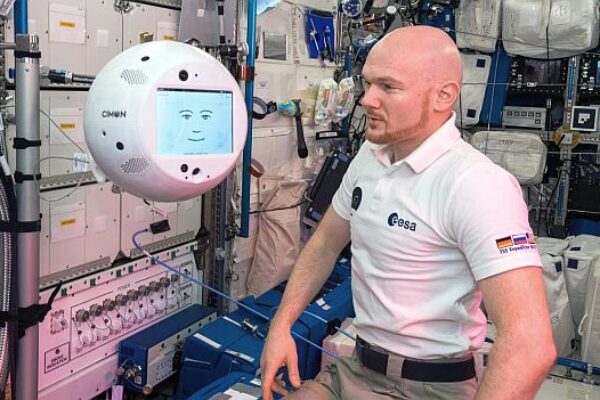
Floating AI robot assists astronauts on the ISS
A virtual assistant robot, CIMON, which stands for “Crew Interactive Mobile Companion,” is an 11-lb plastic orb that uses IBM’s Watson AI technology. It was developed by Airbus on behalf of the German Aerospace Center (DLR) as an intelligent, mobile, and interactive astronaut assistance system.
“CIMON’s digital face, voice and use of artificial intelligence make it a ‘colleague’ to the crew members,” says Matthias Biniok, IBM Lead Watson Architect for Germany, Switzerland, and Austria. “This collegial ‘working relationship’ facilitates how astronauts work through their prescribed checklists of experiments, now entering into a genuine dialogue with their interactive assistant.”
CIMON was activated last week on the ISS by German ESA astronaut Alexander Gerst with the command, “Wake up, CIMON!” Watson speech and vision technologies helped train CIMON to recognize Gerst, using voice samples and Gerst, as well as “non-Gerst” images. Together, says IBM, CIMON and Gerst, who has been living and working on the ISS since June 8, performed several tasks designed to test the AI robot’s technology.
CIMON demonstrated its assistance skills and, on its display “face,” showed instructions for a student experiment on crystallization. The robot also flew some maneuvers, recorded a video and photos with its integrated camera, and played music.
CIMON is able to recognize faces and respond to spoken commands and requests with the aid of voice-controlled AI hosted in the IBM Cloud. Two cameras provide CIMON with the data it needs to perform facial recognition, while five other cameras are used for orientation and video documentation.
CIMON’s “ears” consist of eight microphones for directional recognition plus a directional microphone for good speech recognition. Its mouth is a loudspeaker through which it can speak and play music.
Twelve internal fans enable CIMON to move and rotate freely in all directions. In this way, CIMON can turn to a particular astronaut when addressed, nod or shake its head and follow the astronaut spatially, independently or on command.
“CIMON’s creators are confident that social interactions between humans and machines, in this case between astronauts and a space attendant, equipped with emotional intelligence could make an important contribution to mission success,” says Biniok. “We predict that assistance systems of this kind also have a bright future right here on earth, such as in hospitals or to support nursing care.”
Related articles:
Augmented reality to assist astronauts
NASA sensor to study tiny space debris around ISS
IBM AI toolset targets nine industries, professions
 If you enjoyed this article, you will like the following ones: don't miss them by subscribing to :
eeNews on Google News
If you enjoyed this article, you will like the following ones: don't miss them by subscribing to :
eeNews on Google News




